"Cherishing Little Steps - A Haven for Baby and Family Journeys"
Baby Size 3 Shoes
In the world of tiny toes, where every step holds the promise of growth and development, the importance of proper footwear cannot be overstated. Just as a sturdy foundation supports a towering structure, size 3 shoes provide the necessary support and stability for your baby’s first steps.
As they embark on this exciting milestone, it is crucial to select the right style and materials that cater to their delicate needs.
Join us as we delve into the world of baby size 3 shoes, offering guidance on measuring, caring, and styling for the utmost comfort and style.
Key Takeaways
- Proper footwear supports healthy foot development in infants.
- Size 3 shoes provide support and stability during the transition from crawling to walking.
- Choosing the right size ensures comfort and prevents foot problems.
- Size 3 shoes offer a gradual transition from crawling to walking.
The Importance of Proper Footwear for Babies
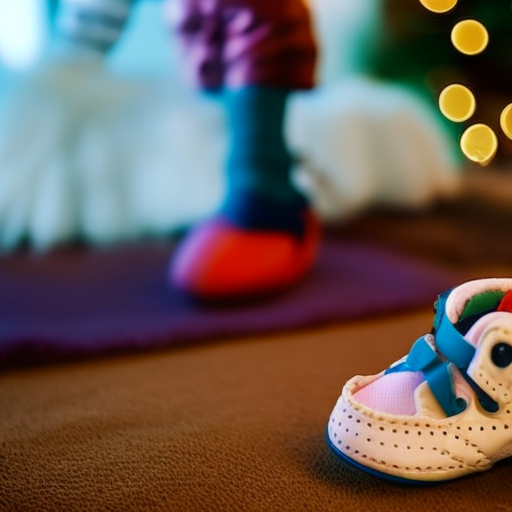
The article discusses the importance of proper footwear for babies. It emphasizes the need for caregivers to ensure the correct fit and support for their developing feet.
It is crucial to consider the benefits of barefoot walking for babies and the common foot problems they may encounter. Babies’ feet are soft and pliable, constantly growing and developing. Allowing them to walk barefoot as much as possible helps strengthen the muscles and ligaments in their feet. Barefoot walking also enhances their balance and coordination, as it allows them to feel the ground beneath them and adjust their movements accordingly.
However, there are instances where babies need to wear footwear to protect their feet from potential hazards or weather conditions. In such cases, it is important to choose shoes that provide the right fit and support. Ill-fitting shoes can interfere with the natural development of the feet and lead to foot problems later in life.
Common foot problems in babies include flat feet, toe abnormalities, and ingrown toenails. Wearing properly fitting shoes with appropriate article determiners can help prevent these issues. Caregivers should ensure that the shoes have enough space for the toes to wiggle, a flexible and non-slip sole, and proper arch support.
Understanding the Size 3 Shoe Standard
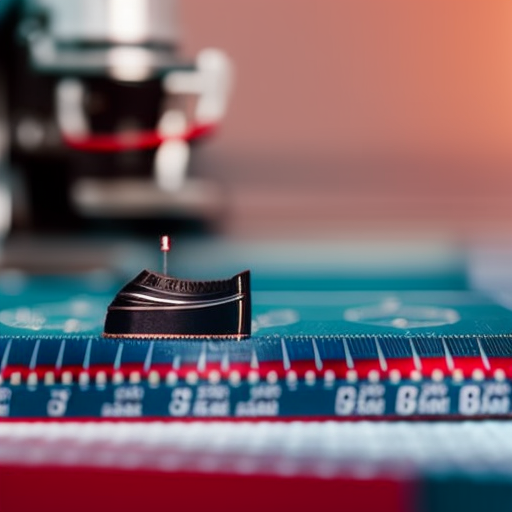
Size 3 is a commonly accepted standard for baby shoes, and understanding its specifications is crucial for caregivers when selecting the appropriate footwear for their little ones. Proper sizing ensures comfort, support, and proper foot development.
To understand the size 3 shoe standard, it is important to be familiar with shoe sizing and the shoe size conversion chart.
Shoe sizing can be a complex process due to variations in measurement systems used by different manufacturers. However, the shoe size conversion chart provides a useful tool for caregivers to determine the correct size for their baby. This chart converts foot length measurements into corresponding shoe sizes, taking into account the different sizing standards used in various countries.
When using the shoe size conversion chart, caregivers should measure their baby’s foot length accurately by placing their foot against a flat surface and measuring from the heel to the longest toe. This measurement can then be used to determine the appropriate size based on the conversion chart.
Understanding shoe sizing and utilizing the shoe size conversion chart allows caregivers to select the right size 3 shoes for their baby, promoting healthy foot development and ensuring comfort and support. By providing the correct footwear, caregivers can serve their little ones’ needs and contribute to their overall well-being.
Benefits of Size 3 Shoes for Baby’s First Steps

For baby’s first steps, caregivers can emphasize the benefits of size 3 shoes by providing proper support and stability during this crucial developmental milestone. Size 3 shoes are specifically designed to accommodate the growing feet of babies who are transitioning from crawling to walking.
Here are four reasons why size 3 shoes are beneficial for babies:
-
Enhanced support: Baby shoe brands understand the importance of providing adequate support for growing feet. Size 3 shoes are designed with features such as cushioned insoles and ankle support to promote proper alignment and reduce the risk of injury.
-
Stability: Size 3 shoes offer a stable base for babies to balance and take their first steps. The non-slip soles provide traction and prevent slipping, allowing babies to explore their environment with confidence.
-
Protection: As babies venture into the world of walking, their feet are exposed to various hazards. Size 3 shoes with durable materials and reinforced toe caps offer protection against sharp objects and uneven surfaces.
-
Gradual transition: While there are benefits of walking barefoot, size 3 shoes provide a gradual transition from crawling to walking. They offer the necessary support and protection while still allowing babies to feel the ground beneath their feet.
Choosing the Right Style for Your Baby’s Needs
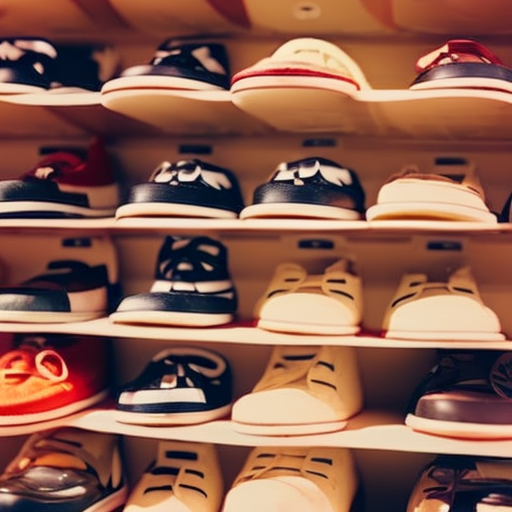
When selecting shoes for your baby, it is important to consider their individual needs and preferences. Baby shoe brands offer a wide range of popular shoe styles to choose from, each with their own unique features and benefits. To help you make an informed decision, we have provided a table below comparing three different baby shoe brands and their popular shoe styles:
| Baby Shoe Brand | Popular Shoe Styles |
|---|---|
| Brand A | Sneakers, Mary Janes |
| Brand B | Sandals, Moccasins |
| Brand C | Boots, Ballet Flats |
By understanding the specific needs of your baby, you can select the right style that will provide them with the comfort and support they need. For example, if your baby is just starting to walk, sneakers from Brand A may be a good option as they provide stability and cushioning. On the other hand, if your baby enjoys being barefoot, moccasins from Brand B could be a great choice as they offer a soft and flexible sole.
How to Measure Your Baby’s Feet for Size 3 Shoes
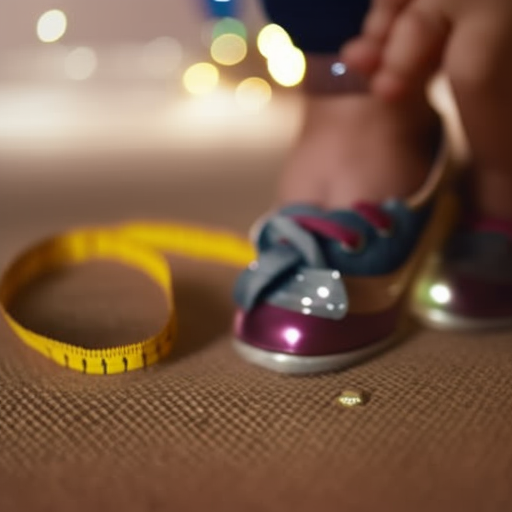
To ensure a proper fit, measure your baby’s feet carefully and accurately with a tape measure or ruler, and take note of the measurements. This is especially important when buying size 3 shoes for your little one. Size 3 is typically designed for babies who are around 6-9 months old and have feet that measure approximately 4.125 inches (10.5 cm) in length.
Here are some tips to help you measure your baby’s feet correctly and choose the right size:
-
Use a tape measure or ruler: Measure your baby’s feet while they are standing or sitting with their toes flat on the ground. Make sure the tape measure or ruler is positioned straight and level.
-
Measure both feet: It is common for babies to have slightly different-sized feet. Always measure both feet and use the larger measurement when selecting shoes.
-
Consider the width: In addition to length, pay attention to the width of your baby’s feet. Some brands offer different width options to accommodate wider or narrower feet.
-
Check the shoe brand’s sizing chart: Different baby shoe brands may have slight variations in size. Consult the brand’s sizing chart to ensure you are choosing the correct size for your baby.
Finding the Perfect Fit: Tips for Shoe Shopping
Finding the right fit is essential when it comes to shoe shopping. Ill-fitting shoes can lead to a range of foot problems, including blisters, bunions, and even long-term issues such as misalignment and posture problems.
To ensure a proper fit and avoid these problems, there are a few key tips to keep in mind.
Firstly, it is important to measure your feet regularly, as our foot size can change over time. Use a measuring tape or visit a professional shoe store for accurate measurements.
Secondly, when trying on shoes, always allow for some wiggle room in the toe area. Your toes should not feel cramped or squished together. Additionally, pay attention to the width of the shoe – it should not feel too tight or too loose.
Another tip is to try on shoes at the end of the day, as our feet tend to swell throughout the day. This will give you a more accurate idea of how the shoes will fit during regular wear.
Lastly, walk around in the shoes to ensure they provide proper support and stability. Your feet should feel comfortable and secure.
Material Matters: Which Shoe Materials Are Best for Baby
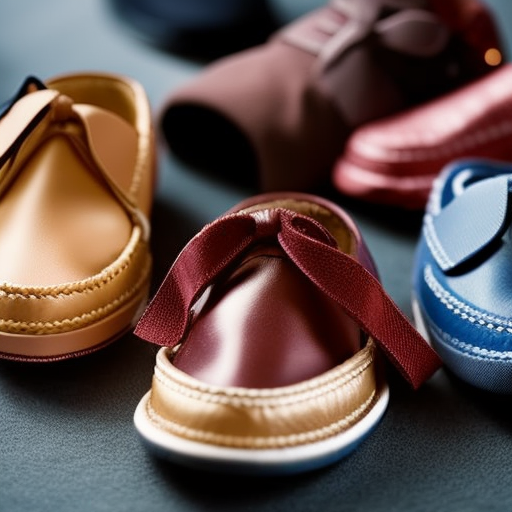
Choosing the appropriate shoe materials for babies is crucial to ensure their comfort and foot health. When it comes to selecting the best shoe brands for your little one, it’s important to consider durability and longevity.
Here are four materials that are commonly used in baby shoes, known for their quality and benefits:
-
Leather: Leather is a popular choice for baby shoes because of its durability and breathability. It provides a comfortable fit and allows the feet to breathe, reducing the risk of irritation or discomfort.
-
Canvas: Canvas is another excellent option for baby shoes. It is lightweight, flexible, and allows for good airflow, keeping the feet cool and comfortable. Canvas shoes are also easy to clean, making them a practical choice for busy parents.
-
Suede: Suede is a soft and supple material that offers a luxurious feel for your baby’s feet. It is known for its durability and ability to withstand wear and tear. Suede shoes also provide good traction, helping your little one maintain stability while learning to walk.
-
Mesh: Mesh is a lightweight and breathable material that is perfect for warm weather. It allows air to circulate freely, keeping your baby’s feet cool and dry. Mesh shoes are also flexible, allowing for natural foot movement and promoting healthy development.
Caring for Size 3 Shoes: Cleaning and Maintenance Tips

The proper cleaning and maintenance of size 3 shoes is essential for ensuring their longevity and continued comfort for the child. Size 3 shoes are designed specifically for babies who are taking their first steps, and as such, they require special attention to keep them in good condition. Here are some cleaning and maintenance tips to help parents take care of their baby’s size 3 shoes:
| Cleaning Tips | Maintenance Tips |
|---|---|
| – Use a soft cloth or sponge to remove any dirt or stains on the surface of the shoes. | – Check the shoes regularly for any signs of wear and tear, such as loose stitching or worn-out soles. |
| – For stubborn stains, use a mild detergent mixed with water to gently scrub the affected area. | – Store the shoes in a cool and dry place to prevent the growth of mold or bacteria. |
| – Avoid using harsh chemicals or abrasive cleaners, as they can damage the material of the shoes. | – If the shoes get wet, allow them to air dry naturally. Avoid using direct heat sources, as they can warp the shape of the shoes. |
Transitioning to Size 4: When Is It Time for a New Pair

Parents should consider the growth of their child’s feet and the signs of discomfort as they decide when it is necessary to transition to a new pair of size 4 shoes. It is important to monitor the fit of the current size 3 shoes and observe any redness, blisters, or difficulty in walking that may indicate the need for a larger size.
Here are four important factors to consider when transitioning to a new pair:
-
Size: As children’s feet grow rapidly, it is crucial to ensure that the new shoes are of the correct size. Measure the child’s feet regularly to determine the appropriate size and allow for some room for growth.
-
Comfort: A child’s comfort should be a priority when choosing new shoes. Look for shoes with cushioning, proper arch support, and a flexible sole to ensure a comfortable fit.
-
Durability: Children can be quite active, so it’s important to choose shoes made from durable materials that can withstand wear and tear.
-
Style: While functionality is key, it’s also important to find shoes that your child finds appealing. Let them be involved in the selection process to encourage their independence and boost their confidence.
Styling Tips: Matching Outfits With Size 3 Shoes
To create a cohesive look, consider coordinating your child’s outfits with their size 3 shoes by incorporating complementary colors or patterns. Matching colors and accessorizing with shoes can elevate the overall style of your child’s outfit. When choosing outfits, take into account the color palette of the shoes.
For example, if your child is wearing a pair of pink size 3 shoes, you can opt for outfits that have hints of pink or complementary colors like white or light gray. This will create a harmonious and put-together appearance.
In addition to matching colors, you can also consider patterns when coordinating outfits with size 3 shoes. For instance, if your child’s shoes have floral patterns, you can choose an outfit that incorporates a similar floral print or a complementary pattern like stripes or polka dots. This will add visual interest and create a cohesive look.
Accessorizing with the right shoes can make a significant impact on the overall style and appearance of your child’s outfit. Size 3 shoes provide an opportunity to showcase your child’s personality and fashion sense. By following these styling tips and paying attention to matching colors and patterns, you can create stylish and coordinated outfits that are sure to turn heads.
Frequently Asked Questions
Are Size 3 Shoes Suitable for Babies Who Are Just Starting to Walk?
Size 3 shoes are suitable for babies who are just starting to walk. According to the baby shoe size guide, it is important to provide proper fitting shoes for a baby’s development.
Can I Use Size 3 Shoes for My Baby Even if Their Feet Measure Smaller or Larger Than the Standard Size?
When considering the use of size 3 shoes for babies with smaller or larger feet, it is important to find the right fit. Ensuring proper support and comfort is crucial for the development of their walking skills.
How Often Should I Measure My Baby’s Feet to Ensure They Are Still the Right Size for Size 3 Shoes?
To ensure the measuring accuracy and the right fit of baby’s shoes, it is recommended to measure their feet every 2-3 months or during growth spurts. This will help determine if size 3 shoes are still appropriate.
Are There Any Specific Features or Characteristics I Should Look for When Choosing Size 3 Shoes for My Baby?
When choosing size 3 shoes for your baby, it is important to consider specific features and characteristics. Look for reputable baby shoe brands that offer proper support and flexibility. Ensure you measure your baby’s feet accurately to find the right fit.
Can I Machine Wash Size 3 Shoes or Are They Only Suitable for Handwashing?
Machine washing vs handwashing for size 3 shoes is a common concern among parents. While some size 3 shoes may be suitable for machine washing, it is recommended to check the manufacturer’s guidelines to ensure proper care. Additionally, size 3 shoes can be used for toddlers who are not walking yet, as they provide protection and support for their growing feet.
Conclusion
In conclusion, proper footwear is essential for babies, especially when they are taking their first steps. Size 3 shoes provide numerous benefits for their development and comfort.
It is important to measure your baby’s feet accurately and choose the right style and materials for their needs. Additionally, taking care of size 3 shoes through regular cleaning and maintenance will prolong their lifespan.
As your baby grows, keep an eye out for signs that it is time to transition to size 4 shoes. Remember to match their size 3 shoes with stylish outfits for a complete look.


